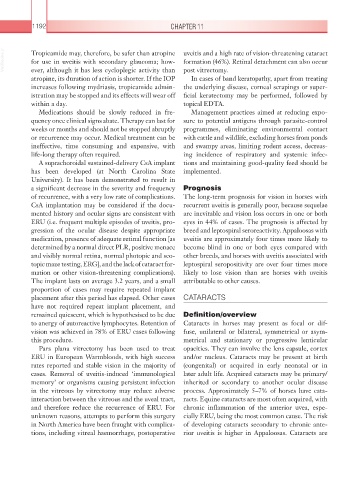Page 1217 - Equine Clinical Medicine, Surgery and Reproduction, 2nd Edition
P. 1217
1192 CHAPTER 11
VetBooks.ir Tropicamide may, therefore, be safer than atropine uveitis and a high rate of vision-threatening cataract
formation (46%). Retinal detachment can also occur
for use in uveitis with secondary glaucoma; how-
ever, although it has less cycloplegic activity than
atropine, its duration of action is shorter. If the IOP post vitrectomy.
In cases of band keratopathy, apart from treating
increases following mydriasis, tropicamide admin- the underlying disease, corneal scrapings or super-
istration may be stopped and its effects will wear off ficial keratectomy may be performed, followed by
within a day. topical EDTA.
Medications should be slowly reduced in fre- Management practices aimed at reducing expo-
quency once clinical signs abate. Therapy can last for sure to potential antigens through parasite-control
weeks or months and should not be stopped abruptly programmes, eliminating environmental contact
or recurrence may occur. Medical treatment can be with cattle and wildlife, excluding horses from ponds
ineffective, time consuming and expensive, with and swampy areas, limiting rodent access, decreas-
life-long therapy often required. ing incidence of respiratory and systemic infec-
A suprachoroidal sustained-delivery CsA implant tions and maintaining good-quality feed should be
has been developed (at North Carolina State implemented.
University). It has been demonstrated to result in
a significant decrease in the severity and frequency Prognosis
of recurrence, with a very low rate of complications. The long-term prognosis for vision in horses with
CsA implantation may be considered if the docu- recurrent uveitis is generally poor, because sequelae
mented history and ocular signs are consistent with are inevitable and vision loss occurs in one or both
ERU (i.e. frequent multiple episodes of uveitis, pro- eyes in 44% of cases. The prognosis is affected by
gression of the ocular disease despite appropriate breed and leptospiral seroreactivity. Appaloosas with
medication, presence of adequate retinal function [as uveitis are approximately four times more likely to
determined by a normal direct PLR, positive menace become blind in one or both eyes compared with
and visibly normal retina, normal photopic and sco- other breeds, and horses with uveitis associated with
topic maze testing, ERG], and the lack of cataract for- leptospiral seropositivity are over four times more
mation or other vision-threatening complications). likely to lose vision than are horses with uveitis
The implant lasts on average 3.2 years, and a small attributable to other causes.
proportion of cases may require repeated implant
placement after this period has elapsed. Other cases CATARACTS
have not required repeat implant placement, and
remained quiescent, which is hypothesised to be due Definition/overview
to anergy of autoreactive lymphocytes. Retention of Cataracts in horses may present as focal or dif-
vision was achieved in 78% of ERU cases following fuse, unilateral or bilateral, symmetrical or asym-
this procedure. metrical and stationary or progressive lenticular
Pars plana vitrectomy has been used to treat opacities. They can involve the lens capsule, cortex
ERU in European Warmbloods, with high success and/or nucleus. Cataracts may be present at birth
rates reported and stable vision in the majority of (congenital) or acquired in early neonatal or in
cases. Removal of uveitis-induced ‘immunological later adult life. Acquired cataracts may be primary/
memory’ or organisms causing persistent infection inherited or secondary to another ocular disease
in the vitreous by vitrectomy may reduce adverse process. Approximately 5–7% of horses have cata-
interaction between the vitreous and the uveal tract, racts. Equine cataracts are most often acquired, with
and therefore reduce the recurrence of ERU. For chronic inflammation of the anterior uvea, espe-
unknown reasons, attempts to perform this surgery cially ERU, being the most common cause. The risk
in North America have been fraught with complica- of developing cataracts secondary to chronic ante-
tions, including vitreal haemorrhage, postoperative rior uveitis is higher in Appaloosas. Cataracts are

